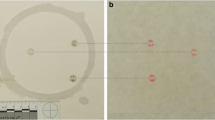Abstract
In contact shots, the muzzle imprint is an informative finding associated with the entrance wound. It typically mirrors the constructional components being in line with the muzzle or just behind. Under special conditions, other patterned skin marks located near a gunshot entrance wound may give the impression to be part of the muzzle imprint. A potential mechanism causing a patterned pressure abrasion in close proximity to the bullet entrance site is demonstrated on the basis of a suicidal shot to the temple. The skin lesion in question appeared as a ring-shaped excoriation with a diameter corresponding to that of the cartridge case. Two hypotheses concerning the causative mechanism were investigated by test shots: - After being ejected, the cartridge case ricocheted inside a confined space (car cabin in the particular case) and secondarily hit the skin near the gunshot entrance wound. - The ejection of the cartridge case failed so that the case became stuck in the ejection port and its mouth contacted the skin when the body collapsed after being hit.








Similar content being viewed by others
References
Collins KA, Lantz PE (1994) Interpretation of fatal, multiple, and exiting gunshot wounds by trauma specialists. J Forensic Sci 39:94–99
Di Maio VJM (1999) Gunshot wounds, 2nd edn. CRC Press, Boca Raton, pp 256–257
Pollak S (2007) Medical criminalistics: Forensic Sci Int 165:144–149
Pollak S, Saukko P (2013) Gunshot wounds. In: Siegel JA, Saukko PJ (eds) Encyclopedia of forensic sciences, vol 3, 2nd edn. Academic Press, London, pp 70–82
Werkgartner A (1924) Eigenartige Hautverletzungen durch Schüsse aus angesetzten Selbstladepistolen. Beitr Gerichtl Med 6:148–161
Werkgartner A (1928) Schürfungs- und Stanzverletzungen der Haut am Einschuss durch die Mündung der Waffe. Dtsch Z Gesamte Gerichtl Med 11:154–168
Hausbrandt F (1944) Experimentelle Studien zur Entstehungsmechanik und Morphologie einiger Nahschusszeichen. Dtsch Z Gesamte Gerichtl Med 38:45–76
Elbel H (1958) Studien zur Entstehung der Stanzverletzungen bei absoluten Nahschüssen. Med Welt 20:343–345
Geserick G, Vendura K, Wirth I (2009) Werkgartner’s muzzle imprint mark—a literature study. Arch Kriminol 224:145–157
Pollak S, Rothschild MA (2004) Gunshot injuries as a topic of medicolegal research in the German-speaking countries from the beginning of the 20th century up to the present time. Forensic Sci Int 144:201–210
Rothschild MA, Vendura K (1999) Fatal neck injuries caused by blank cartridges. Forensic Sci Int 101:151–159
Große Perdekamp M, Braunwarth R, Pollak S (2008) Patterned imprint mark due to the folded shoulder stock: a possible finding in contact shots from submachine guns. Forensic Sci Int 178:e1–e5
Große Perdekamp M, Glardon M, Kneubuehl BP, Bielefeld L, Nadjem H, Pollak S, Pircher R (2015) Fatal contact shot to the chest caused by the gas jet from a muzzle-loading pistol discharging only black powder and no bullet: case study and experimental simulation of the wounding effect. Int J Legal Med 129:125–131
Große Perdekamp M, Nadjem H, Merkel J, Braunwarth R, Pollak S, Thierauf A (2011) Two-gun suicide by simultaneous shots to the head: interdisciplinary reconstruction on the basis of scene investigation, autopsy findings, GSR analysis and examination of firearms, bullets and cartridge cases. Int J Legal Med 125:479–485
Pollak S, Bauer G, Friedrich-Schöler E, Skala O, Stellwag-Carion C (1981) Zur Kasuistik suizidaler Nacken- und Hinterhauptsschüsse. Festschrift für Otto Prokop. Humboldt-Universität, Berlin, pp 72–83
Pircher R, Pollak S (2014) Morphologische Erscheinungsformen nicht penetrierender Schussverletzungen. In: Riepert T (ed) Klinische Rechtsmedizin. Schmidt-Römhild, Lübeck, pp 111–117
Pollak S, Lindermann A (1990) Verletzungsbilder und Röntgenbefunde nach Schüssen mit selten verwendeter Flintenmunition. Beitr Gerichtl Med 48:507–518
Pollak S, Saukko P (2013) Humane killing tools. In: Siegel JA, Saukko PJ (eds) Encyclopedia of forensic sciences, vol 4, 2nd edn. Academic Press, London, pp 130–135
Kneubuehl BP (2011) Wound ballistics of bullets and fragments. In: Kneubuehl BP (ed) Coupland RM, Rothschild MA, Thali MJ: Wound Ballistics—Basics and Applications. Springer, Berlin, pp 163–252
Sellier K, Kneubuehl BP (2001) Wundballistik und ihre ballistischen Grundlagen, 2nd edn. Springer, Berlin, pp 262–271
Kneubuehl BP (2013) Geschosse: Gesamtausgabe – Ballistik. Messtechnik. Wirksamkeit. Treffsicherheit. Stocker-Schmidt, Dietikon-Zürich, pp 142–147
Author information
Authors and Affiliations
Corresponding author
Rights and permissions
About this article
Cite this article
Kramer, L., Nadjem, H., Glardon, M. et al. A patterned abrasion caused by the impact of a cartridge case may simulate an atypical muzzle imprint mark. Int J Legal Med 130, 751–757 (2016). https://doi.org/10.1007/s00414-015-1281-4
Received:
Accepted:
Published:
Issue Date:
DOI: https://doi.org/10.1007/s00414-015-1281-4




